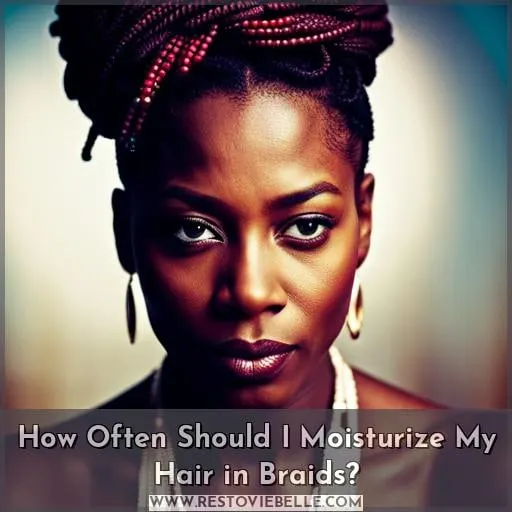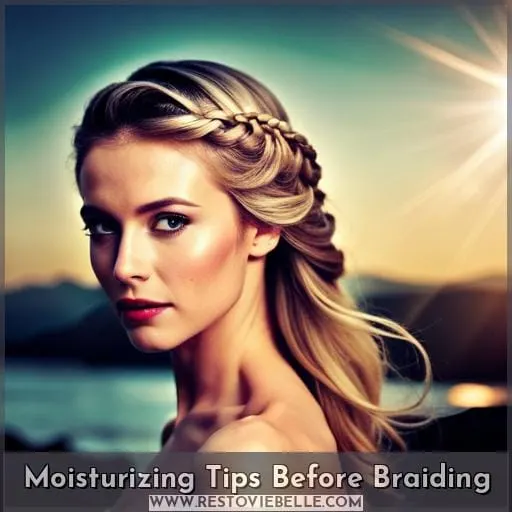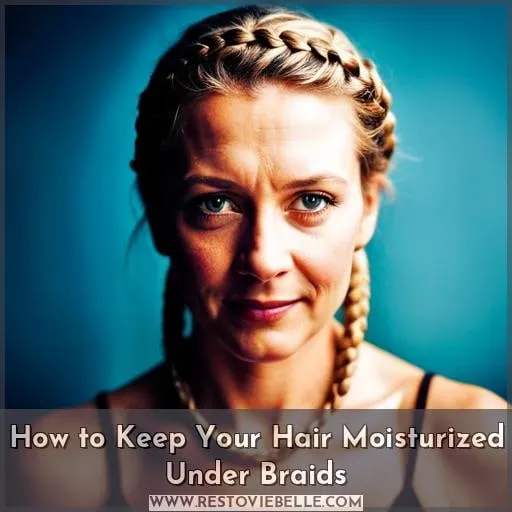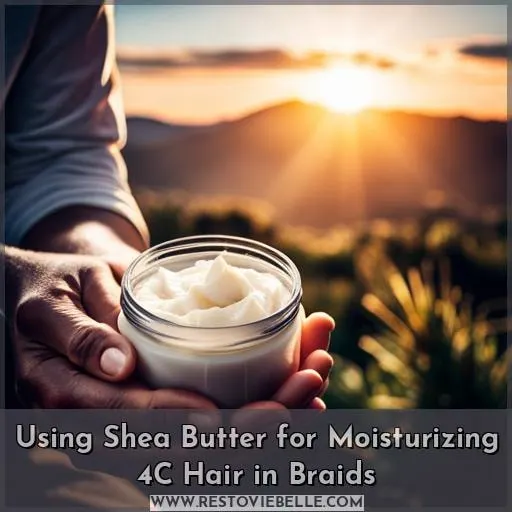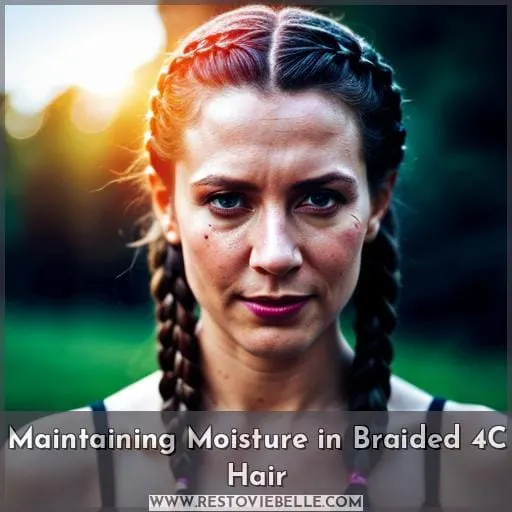This site is supported by our readers. We may earn a commission, at no cost to you, if you purchase through links.
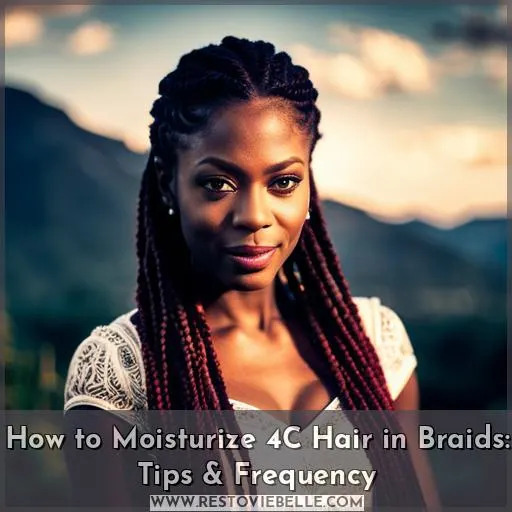 Understanding how to moisturize 4C hair in braids is essential for achieving beautiful, defined locks that will last. Just like a majestic garden filled with vibrant flowers blooming against the backdrop of lush green grass needs water and care to flourish, so too does our crowning glory need nourishment and upkeep.
Understanding how to moisturize 4C hair in braids is essential for achieving beautiful, defined locks that will last. Just like a majestic garden filled with vibrant flowers blooming against the backdrop of lush green grass needs water and care to flourish, so too does our crowning glory need nourishment and upkeep.
But if you’ve been asking yourself How often should I moisturize my 4C hair in braids? then fear not! In this article, we take a deep dive into understanding the best way to keep your natural curls hydrated while wearing protective styles like box braiding.
From learning about factors affecting frequency such as porosity or climate/seasonal changes through to uncovering tips on preventing buildup from daily spritzing – there’s something here for everyone looking after their mane!
Table Of Contents
- Key Takeaways
- Best Way to Moisturize 4C Hair in Braids
- How Often Should I Moisturize My Hair in Braids?
- Moisturizing Tips Before Braiding
- Dos and Don’ts of Braiding Hair
- How to Keep Your Hair Moisturized Under Braids
- Using Shea Butter for Moisturizing 4C Hair in Braids
- Preventing Buildup From Daily Moisturizing
- Can You Over-Moisturize 4C Hair in Braids?
- How Often to Wash 4C Hair in Braids?
- Maintaining Moisture in Braided 4C Hair
- Frequently Asked Questions (FAQs)
- Conclusion
Key Takeaways
- Moisturize 4C hair in braids regularly with water-based moisturizers and leave-ins.
- Deep condition every two weeks to balance moisture levels and protect against damage.
- Utilize a moisturize and seal technique with natural oils to maintain hydration.
- Protect hair at night with a satin bonnet or scarf to prevent moisture loss.
Best Way to Moisturize 4C Hair in Braids
You take great care of your 4C hair, so you know the importance of moisturizing it in braids. Water-based moisturizers and leave-ins are essential for nourishing your curls, as is a regular moisturize and seal technique using natural oils such as coconut, almond, or argan.
Don’t forget to deep condition every two weeks too – this will help keep moisture levels balanced while protecting against damage caused by environmental factors.
Water-Based Moisturizers and Leave-Ins
Using water-based moisturizers and leave-ins is a great way to ensure your 4C hair stays hydrated while in braids, keeping it healthy and defined for longer. Shea butter can be used as an effective moisturizer or sealant; however, avoid excess buildup by limiting regular moisturizing sessions.
It’s best to use a lightweight leave-in conditioner with water as the main ingredient every 2–3 days during wear time of the braids and apply shea butter thereafter if needed.
A weekly deep conditioning routine will help prevent hygral fatigue, breakage caused by lack of moisture when protective styling like cornrows or box braids are worn for extended periods of time without proper maintenance.
Make sure you incorporate all these tips into your haircare regimen so that you keep your natural curls looking beautiful year-round!
Moisturize and Seal Technique
You can use oils, butters, or gels to moisturize and seal your 4C hair in braids every few days for optimal hydration. For the best results, a water-oil mix with vegetable glycerin and a hydrating conditioner is ideal.
Additionally, you could also use aloe vera gel, as well as natural oils like coconut oil, to keep your hair deeply conditioned.
Braiding sprays are an excellent way of refreshing moisture levels between deep treatments. Sleeping with a satin bonnet or scarf protects against nightly moisture loss due to friction on cotton pillowcases.
Finally, incorporate leave-in conditioners into weekly routines for extra nourishment that won’t weigh down curls!
Deep Conditioning
Weekly deep conditioning is a must to keep your 4C braids hydrated and healthy. Deep conditioners are formulated to repair the hair cuticle, add shine, increase moisture and elasticity while providing revitalization.
Use sealing oils like coconut or jojoba on damp hair after applying the conditioner for best results – this helps lock in moisture and prevents hygral fatigue (over-moisturizing). Scalp oiling should be done 2-3 times weekly as well as washing with shampoo/conditioner every two weeks or more depending on activity level.
How Often Should I Moisturize My Hair in Braids?
Maintaining healthy, moisturized 4C hair in braids requires an understanding of factors that affect the frequency of your moisturizing routine. Hair porosity, climate, and seasonal changes can have a drastic effect on moisture needs, as well as nighttime protection to reduce water loss from your strands.
Therefore, it is essential to find balance when determining how often you should moisturize your hair in braids.
Factors Affecting Moisturizing Frequency
Understanding the factors affecting your moisturizing frequency is key to keeping 4C hair healthy and protected in braids! Hair porosity, climate changes, night protection, and hair ratio all play a role.
Porosity level affects moisture retention; climate influences needs; satin bonnets/pillowcases are essential for night protection; proper hair-to-braiding ratio keeps tension at bay. Moisturize regularly with conditioner & oil while ensuring balanced maintenance for best results.
Hair Porosity
Knowing your hair’s porosity helps determine how frequently you should moisturize your 4C coils in braids. For instance, low porosity may require more frequent hydration with a spritz of water and oil.
Hair types that are high porosity can benefit from natural oils like coconut or jojoba, as well as shea butter, to seal in moisture without buildup.
Consider the LCO method when moisturizing: leave-in conditioner followed by cream or serum, then sealed with an oil. Climate change and weather fluctuations also play a role, so adjust accordingly if needed.
Climate and Season
It’s important to consider climate and season when adjusting your moisturizing routine for braided 4C hair. In dry climates or during colder months, you may need to increase the frequency of water-based moisturizers and sealants such as oils, butters, or gels.
Night protection is also essential with satin bonnets/pillowcases, preventing moisture loss from braids while aiding in product buildup prevention.
Nighttime Protection
Sleeping on a satin bonnet or silk pillowcase is vital to prevent nighttime moisture loss and maintain healthy braided 4C hair. Wearing one can reduce friction by up to 50%. To maximize the effects, consider oil sealing with natural oils like coconut, almond, jojoba, or argan before bed.
Co-washing (conditioner wash) every two weeks helps keep the scalp and hair clean without stripping away essential oils needed for long braided hair health.
Nighttime maintenance must be consistent in order to see results from all the other moisturizing techniques you’re using throughout your day, such as LCO/LOC methods and squish to condish technique.
Moisturizing Tips Before Braiding
Before braiding your 4C hair, it’s essential to thoroughly moisturize and prepare it for a healthy style. To avoid buildup and ensure that the protective benefits of braids last, make sure you wash your hair regularly with shampoo or conditioner.
Incorporate regular natural hair care into your routine, such as implementing an LOC/LCO method for deep hydration or using satin bonnets at night to retain moisture.
Thoroughly Moisturize Your Hair
Prepare your hair with a thorough moisturizing routine before braiding to keep it healthy and hydrated.
Moisturize daily using hydrating masks, conditioning treatments, or protein treatments.
Seal in the moisture with oils like avocado oil, then follow up with a hot oil treatment once per week for lasting moisture.
When braiding, use tight enough tension to ensure protection, but not too much that will create discomfort or scalp issues. Also, avoid excessive weight due to an imbalance of natural hair-to-braiding hair ratio.
Regularly clarify shampoo and use the squish to condish technique as needed for intense hydration while avoiding moisture overload, which can lead to breakage and damage over time!
Proper Hair Washing
Making sure your scalp is clean before braiding helps keep hair healthy, so wash it regularly with a shampoo and conditioner designed for 4C hair.
Protective hairstyles can reduce moisture loss but require maintenance. Use the proper ratio of braid to natural hair and avoid tight braids to prevent tension, itchiness, or damage.
Co-washing is also an option – just make sure you rinse out all residues from styling products like shea butter!
Over-moisturizing causes hygral fatigue, which leads to breakage too. So try not to do this with a technique such as LOC/LCO every few days instead.
Washing your braided 4C locks weekly will help ensure balanced hydration levels without the risk of buildup or over-moisturization.
Regular Natural Hair Care
Maintaining a balanced natural hair care routine is key to keeping your 4C braids looking their best, so don’t forget: an ounce of prevention is worth a pound of cure!
Regularly moisturizing with water or leave-in conditioner and sealing with oil, butter, or gel are essential steps.
Other tips include protective hairstyles such as braiding or twisting; scalp oiling 2-3 times a week; using the LOC method for deep hydration and defined curls; hydrating braid refresher spray; avoiding heat damage and hygral fatigue by night protection with a satin bonnet or scarf – all of these help create healthy locks in style.
Keep up consistent care for gorgeous results without breakage!
Dos and Don’ts of Braiding Hair
It’s essential to properly moisturize 4C hair in braids, as well as avoid tight braiding and an improper hair-to-braiding ratio. Additionally, the duration of wearing your protective style should be considered carefully.
Proper Moisturization
You need to keep your curls hydrated by regularly moisturizing and sealing with oils, butters, or gels. For effective results, apply a deep conditioner weekly or as needed and consider the LOC/LCO method for maximum moisture retention.
Regular scalp oiling (2-3 times per week) is also essential for healthy hair growth under braids. Additionally, use a braid refresher spray containing castor oil after activities that cause sweat; this helps maintain the protective style’s longevity while promoting healthy hair growth.
Water wash or co-wash (conditioner) every two weeks, then seal in moisture with an overnight protection of a satin bonnet/scarf.
Avoiding Tight Braids
Avoiding tight braids when styling 4C hair in protective styles is like walking a tightrope – one wrong move and you can slip off the edge. Hair tension, scalp issues, or excess weight from too many braids are all things to avoid.
Regular washing also helps reduce hygral fatigue and frizz while boosting curl definition – moisturize and seal afterward! Factors like climate affect how often to do this; always use night protection for best results too.
Scalp care is key with any braid style, so keep it clean by oiling 2-3 times weekly and post-activity washing as needed.
Hair-to-Braiding Hair Ratio
It’s essential to ensure the right balance of your hair to braiding hair when styling, as an improper ratio can lead to tension and breakage.
Plant-based braids, such as box braids or cornrows, are a cultural legacy worth protecting.
Protective hairstyles like these should be installed with enough of your own hair for natural movement.
Over-moisturizing can cause hygral fatigue and weaken strands. Aim for balanced moisture levels by using oils and butter seals after washing and conditioning.
Braiding techniques may vary, but one thing remains consistent: respect the power behind this protective style by caring for it properly at each step of the way!
Duration of Wearing Braids
Rejuvenate and refresh your look with braids – but make sure to carefully monitor the duration of wearing them. Braid tension, scalp care, and hair ratio are all factors that influence how long you can wear a braid style without suffering from damage.
Monitor moisture balance for curls by protecting against humidity or heat as well as frequent washing to prevent buildup and keep hair healthy. Additionally, ongoing natural hair care such as oiling is key in maintaining curl power while preventing breakage due to sun exposure or tightness of braiding techniques.
Remember these do’s and don’ts when caring for 4C Hair in Braids: maintain a balanced routine while monitoring your own individual needs!
How to Keep Your Hair Moisturized Under Braids
Maintaining your 4C hair in braids requires a lot of TLC to keep it healthy and looking great. Regular scalp oiling and braid refresher sprays are essential components for providing moisture, hydration, protection, and overall care for your locks.
Regular Scalp Oiling
Regularly drenching your scalp in natural oils like jojoba, almond, argan, or coconut can keep braided 4C hair nourished and hydrated. Incorporate a weekly oil massage to stimulate the follicles for healthy growth while protecting against heat damage.
When selecting an oil, consider your hair porosity – high/low – and decide if you need lighter or heavier options depending on desired results. For optimal moisturizing tips, include an apple cider vinegar rinse after washing.
Establishing a simple yet effective regime will ensure long-lasting luscious locks with minimal maintenance needed!
Braid Refresher Sprays
Revitalize your 4C hair in braids with braid refresher sprays to keep them looking and feeling lusciously hydrated! Pre-moisturizing is key, especially for those with low porosity levels. Natural oils such as coconut, almond, jojoba, or argan oil can help prevent hygral fatigue, which damages curly hair.
Scalp oiling should be done 2–3 times weekly, and a water wash every two weeks will keep the scalp healthy.
Using Shea Butter for Moisturizing 4C Hair in Braids
Applying shea butter to 4C hair in braids is an easy way to provide your tresses with the nourishment they need. Shea butter has amazing conditioning benefits, such as strengthening, softening, and protecting the hair from damage.
To apply it properly, warm a small scoop of pure, unrefined shea butter between your palms or use a double boiler before gently massaging it into clean, damp sections of your braid pattern until fully absorbed.
Benefits of Shea Butter
Unlock the power of shea butter to nourish and protect your beautiful braids, giving them a natural boost in hydration. The uses for shea butter are numerous; its moisturizing benefits can help you achieve healthy, curly hair.
It contains beneficial ingredients such as vitamins A and E that help condition your hair while adding shine.
Application tips should be followed to ensure maximum benefit from this product. Massage it into your scalp, edges, and ends.
Its cultural significance is also worth noting. Shea butter has been traditionally used for centuries in many African countries to reduce inflammation along the hairline or bumps caused by styling products or tension from braiding styles.
Unlock amazing results with this magical combination of traditional knowledge and modern application techniques!
How to Apply Shea Butter
Applying a shea butter-based product regularly to your 4C hair in braids helps maintain healthy hydration and protection from the elements. Shea butter offers natural properties that help avoid buildup, hygral fatigue, and excess weight on the scalp.
For best results when moisturizing, use an LCO or LOC method combined with nightly satin protection for maximum benefit.
Preventing Buildup From Daily Moisturizing
Maintaining proper moisture balance is essential for healthy 4C hair in braids. Avoiding heavy daily moisturizing and washing the braided hair regularly are key steps to prevent buildup from occurring.
To ensure your scalp health, manage a balanced routine that suits your individual needs while keeping an eye out for signs of hygral fatigue or breakage.
Proper Balance of Moisture
Finding the right balance of moisture for your 4C hair in braids is key to keeping them looking their best. Moisturizing frequency varies based on hair’s needs and condition, while sealing oils like coconut, almond, jojoba, or argan can help maintain that balance.
A leave-in conditioner with water as a main ingredient is recommended too! Regular scalp oiling (2-3 times weekly) also helps protect against hygral fatigue, which may lead to breakage.
Avoiding Heavy Daily Moisturizing
Too much of a good thing can leave your 4C hair in braids weighed down with buildup, so make sure to avoid heavy daily moisturizing. Shea butter and water washes are great for keeping moisture levels balanced, but over-moisturizing leads to hygral fatigue and breakage.
Aim for two weekly treatments using the LCO or LOC method instead of excessive application every day; seal with natural oils like coconut, almond, jojoba, or argan oil after each session.
Washing Braided Hair
Washing your braided 4C hair regularly is essential for avoiding buildup, so how often should you do it?
To maintain healthy scalp health and prevent buildup, a good washing routine includes:
- Shampooing every 2-3 weeks.
- Co-washing or water wash weekly.
- Applying shea butter to seal in moisture after each wash.
- Using the LOC or LCO method when moisturizing between washes.
- Brushing out any tangles with a wide tooth comb before shampooing.
This will ensure that your scalp stays clean without removing too much of its natural oils, which can lead to excessive dryness.
Can You Over-Moisturize 4C Hair in Braids?
Do you know the signs of over-moisturizing your 4C hair in braids? Hygral fatigue and breakage are two common issues associated with excessive moisturizing. Understanding these warning signs and taking steps to prevent them is key to keeping your natural hair healthy while wearing protective styles like braids.
Understanding Hygral Fatigue
Understanding hygral fatigue is key to avoiding breakage from over-moisturizing your 4C hair in braids. Hygral fatigue occurs when the hair absorbs too much moisture, resulting in weakened cuticles and subsequent breakage.
To prevent this, maintain a balanced routine of moisturizing and scalp oiling every few days with braid refreshers like Jamaican Black Castor Oil or The Mane Choice. Additionally, deep condition weekly while protecting against moisture loss with satin bonnets or silk pillowcases at night.
Signs of Over-Moisturizing
If you’re noticing that your 4C hair in braids is excessively greasy or has a dry, brittle feel, it could be a sign of over-moisturizing. Hygral fatigue can occur when the moisture balance isn’t maintained properly and buildup prevention strategies are not implemented.
Avoiding these dangers requires knowledge of moisturizing techniques as well as using protective braiding styles to reduce loss. Properly understanding the importance of maintaining moisture balance will help prevent issues associated with hygral fatigue while achieving healthy natural hair goals with minimal effort and time investment.
To ensure success, use gentle products and apply them correctly for best results.
How Often to Wash 4C Hair in Braids?
Keeping your 4C hair healthy and hydrated is essential while wearing braids. Washing your hair on a regular basis, at least every two weeks for the average person or weekly if you are active, helps maintain moisture balance in order to prevent buildup and breakage.
Importance of Regular Washing
Regularly cleaning your scalp and braids is paramount to maintaining healthy hair growth and optimal hydration. Incorporate regular washing into your routine of protective styles as hygral fatigue can occur from lack or excess moisture.
Washing every two weeks keeps the natural oils on the scalp balanced, preventing buildup that leads to unhealthy hair.
Frequency for Active Individuals
For active folks, weekly washing may be necessary to keep 4C hair in braids healthy – ironic, isn’t it? To avoid hygral fatigue and buildup due to humidity changes, regular washing is key. This can vary with hair porosity, climate changes, night protection, and braided hair type.
Keep moisture-sealing oils like coconut or argan handy for your braid refresher sprays! Females often forget that their tresses need love too, so don’t be afraid of a little extra TLC each week! Active individuals should consider frequent scalp oiling (2-3 times/week), post-activity washes, and deep conditioners every two weeks for intense hydration.
Maintaining Moisture in Braided 4C Hair
Maintaining moisture in braided 4C hair is a crucial factor for healthy, protected tresses. To help keep your hair hydrated and nourished while in braids, it is highly recommended to spritz with water or conditioner daily and sleep on satin or silk.
By taking these steps, you can ensure that you enjoy the long-lasting benefits of wearing box braids without worrying about dryness or breakage.
Daily Spritz of Water or Conditioner
Daily Spritzing your 4C hair with a mixture of water and conditioner can help keep it hydrated and healthy in braids. Water retention is crucial for achieving smooth, defined curls that are resistant to damage from daily styling.
Oils will also seal the moisture into the strands while offering scalp cleanliness throughout the day or night.
For deep hydrating of 4C hair in braids, try using a leave-in conditioner once weekly and add an oil as an extra layer of protection against weather changes or dryness caused by sweat during activity.
Sleeping on Satin or Silk
To ensure your 4C hair maintains its moisture while in braids, sleep on a satin or silk pillowcase every night. Switch out your cotton for a more luxurious fabric to help keep the scalp and strands hydrated and free from frizz.
Avoid harsh friction that can cause breakage by wearing an overnight bonnet or even wrapping the locks in a scarf to preserve their natural oils.
For extra protection, moisturize with a light oil like jojoba before putting on the bonnet/scarf. Also, co-wash your hair with conditioner weekly to reduce buildup around braid extensions without creating hygral fatigue, which leads to dryness of both the scalp and hair shafts.
Frequently Asked Questions (FAQs)
What type of products should I use to moisturize my 4C hair in braids?
Use a water- or leave-in-based conditioner, and seal with natural oils like coconut, almond, jojoba, or argan. Implement an LOC/LCO method to maintain moisture balance. Deep condition weekly for intense hydration and protection.
Should I oil my scalp while wearing braids?
Yes, oiling your scalp while wearing braids is important for maintaining healthy hair growth. Try using natural oils like coconut, almond, and jojoba two to three times a week and follow up with a protective nighttime satin bonnet or scarf.
Doing this will keep your hair moisturized without over-moisturizing it – essential for keeping damage at bay.
How do I determine the right hair-to-braiding hair ratio?
Determine the correct ratio by using a few strands of your own hair and comparing them to the braiding hair. Aim for a similar weight, texture, and thickness. If you have finer 4C hair, use less braiding hair to reduce tension on your scalp.
What can I do to prevent hair breakage while wearing braids?
To prevent breakage while wearing braids, use a proper hair-to-braiding ratio and avoid tight braids. Moisturize regularly with water or water-based products, seal in moisture with oils/butters/gels, and keep the scalp clean for healthy growth.
Use a satin bonnet for nighttime protection and deep condition weekly to ensure intense hydration.
What is the best way to protect my hair while wearing braids?
Protecting your hair while wearing braids is key! Moisturize regularly, use the LOC/LCO methods, and deep condition weekly for intense hydration. Sleep on satin or silk to preserve moisture. Avoid tight braids to prevent tension and breakage – opt for a lightweight leave-in conditioner section by section.
Conclusion
You’ve finally arrived at the end of your journey of understanding how to moisturize your 4C hair in braids. Taking the time to properly moisturize your hair before, during, and after braiding is essential for keeping your locks healthy and hydrated.
Remember to take into account factors such as hair porosity, climate, and season, and nighttime protection when determining the frequency of moisturizing. And never forget that proper scalp oiling, braid refresher sprays, and a satin or silk bonnet for nighttime are all important for maintaining moisture in your braids.
To keep your hair looking its best, make sure to also use shea butter for added moisture and avoid over-moisturizing.


